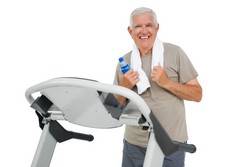Fall prevention for the elderly: The added value of a motor and cognitive intervention
As people age, they often suffer physical and cognitive declines, increasing the risk of falls and serious injury. An intervention minimising such risks would considerably reduce healthcare costs while improving quality of life for the elderly. The EU-funded V-TIME(opens in new window) (Virtual reality-treadmill combined intervention for enhancing mobility and reducing falls in the elderly) project developed a suitable intervention. The innovative system combines treadmill training with virtual reality; subjects walk on the treadmill while engaged in cognitively challenging tasks that are important for safe ambulation. The results, published in the top ranked journal the Lancet, showed improved motor control and fitness along with fewer falls. Research demonstrated that the combined technologies effectively meet the needs of at-risk patients. The multi-centre team assessed over 300 patients, 245 of whom completed the entire 6-week training protocol and the 6 month follow-up. Data analysis indicated that the intervention reduced fall frequency by approximately 40 % more than with treadmill training alone. The outcome reflects the value of intensive training in the target age group and the added value of training in the virtual environment. Results also showed a particular benefit in patients with Parkinson's disease. The virtual reality training reduced their risk of falls by 55 % more than with treadmill training alone, while also improving cognitive function, balance, motor control, and quality of life. The project's training programme also helped to increase step length, foot clearance and obstacle-avoidance strategies. Such techniques also transferred well to the real world. Whereas 100 % of the subjects reported two or more falls in the 6 months prior to the study, approximately 40 % of the study participants had no falls in the 6 months following the trial. A further 20 % had only 1 fall during that period. The V-TIME training programme substantially reduced the risk and consequences of falls. The results promise improved quality of life for older people and lowered public healthcare costs.







